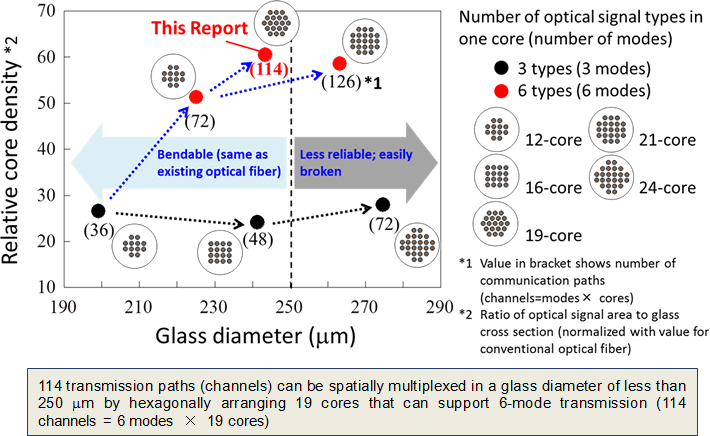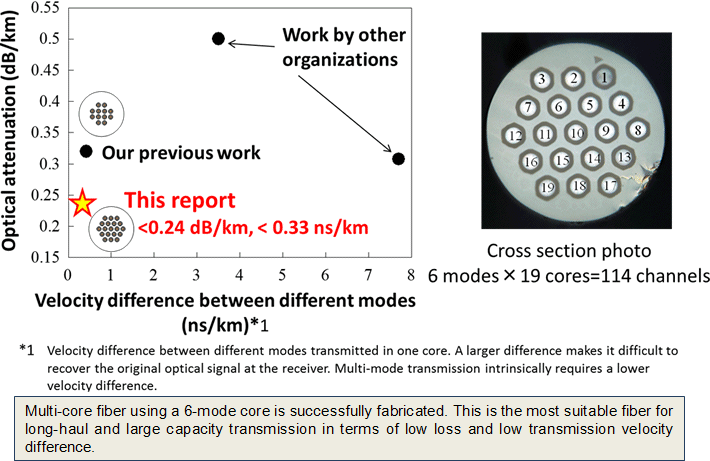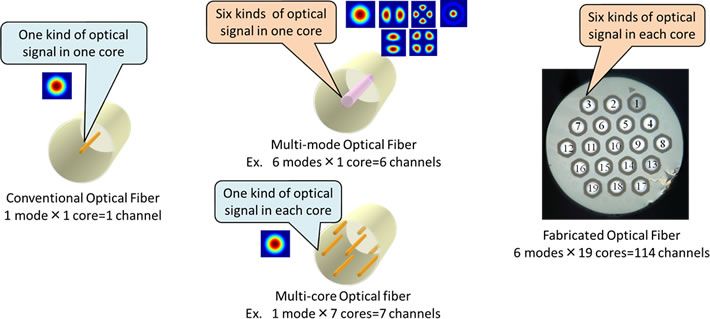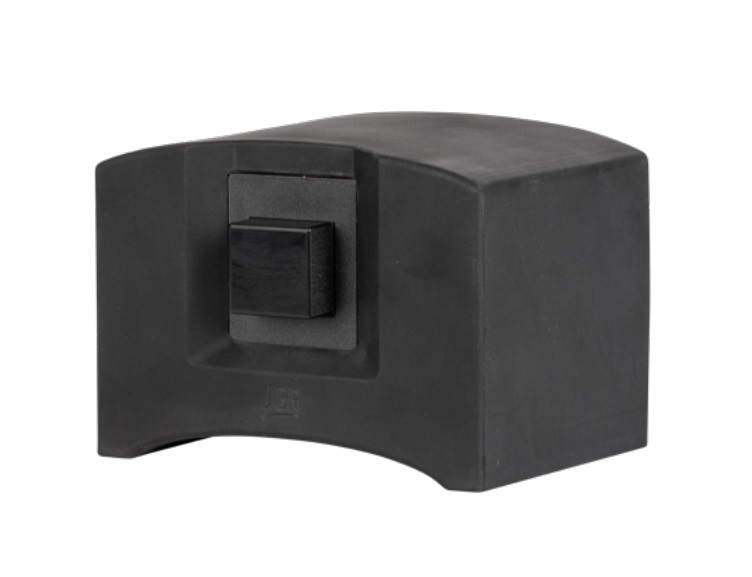May 16, 2016
Researchers from Nippon Telegraph and Telephone Corporation, together with reasarchers from Fujikura Ltd., and Hokkaido University have demonstrated the world’s highest density optical fiber, using a deployable optical fiber diameter of less than 250 µm. This optical fiber contains 19 optical paths (cores) that can support six kinds of optical signals (modes), and it provides 114 (= 6 modes × 19 cores) spatially multiplexed communication paths (channels) in one optical fiber.
A glass diameter of less than 250 µm makes it possible to ensure that optical fiber has sufficient reliability (i.e. bendable fiber that does not break). Accommodating 114 channels in one optical fiber enables us to transfer thousands of HDTV videos per second. The achievement indicates the reality of ultra-large capacity optical fiber that can handle a Peta- to Exa-bit transmission capacity.
"We will continue to contribute to the realization of a future ultra large transmission capacity optical link" the researchers say.
This remarkable achievement was reported in March as a post deadline paper at the Optical Fiber Communication Conference and Exposition (OFC 2016), the largest conference on optical communication in North America, which was held in Anaheim, California, USA.
This work was partially based on work commissioned by the National Institute of Information and Communications Technology (NICT).
Research Background
Recent figures released by the Ministry of Internal Affairs and Communications indicate that the data transmission capacity in Japan exceeded 2.5 Tera-bits per second (Tera = 1012) in November 2013. This trend will require a data capacity of 100 Tera-bits per second by the late 2020s. It is also expected that the capacity crunch facing existing optical fiber, which has one optical path (core) supporting one kind of optical signal (mode), may be reached at the same time. This background means we must install additional optical fibers in the 2020s. However, the maximum number of optical fibers that can be stored in one optical fiber cable is limited. We will also need to construct additional optical wiring infrastructure underground and in buildings, if there is insufficient space in the existing infrastructure.
To address these concerns, worldwide research has been under way on new optical fiber that uses space multiplexing technology. For example, multi-core optical fiber accommodates many cores in one optical fiber, and multi-mode optical fiber supports many modes in one core. However, it is difficult to obtain more than 50 communication paths (channels) using one core or mode multiplexing because of the limit to the glass diameter or the controllability of the refractive index profile. With this as the background, NTT, Fujikura and Hokkaido University (Laboratory of Information Communication Photonics) combined their expertise to realize an optical fiber with more than 100 channels while maintaining a deployable glass diameter by considering the best mix of core- and mode-multiplexing.
Design Guideline of Optical Fiber
NTT has investigated and experimentally confirmed that an optical fiber with a glass diameter of less than 250 µm can be used for over 20 years if an allowable bending radius of 15 - 30 mm is assumed considering actual deployment conditions in the terrestrial optical network. To realize an optical fiber with more than 100 channels, NTT and Hokkaido University numerically derived the optimum refractive index profile for guiding 3 or 6 kinds of optical signal (mode) in one core, and considered various core arrangements that can sufficiently suppress optical signal interference between neighboring cores. As a result, we clarified that a world record 114 channels can be spatially multiplexed when using a glass diameter of less than 250 µm by arranging hexagonally 19 cores that can support 6 modes (114 channels = 6 modes × 19 cores). This design resulted in a core density more than 60 times that in conventional optical fiber, which has one core and supports one mode.

Figure 1 Design guideline for world’s highest core density optical fiber
Fabrication and Evaluation
Using the above design guideline as a basis, Fujikura fabricated an 8.75 km long optical fiber, and NTT evaluated its optical property. The optical attenuation at 1550 nm is less than 0.24 dB/km for all 114 channels, and to the best of our knowledge this is the lowest reported value for multi-core fiber using a 6-mode core. The fabricated optical fiber achieved superior uniformity where the variation in optical attenuation between channels was less than 0.03 dB/km. Moreover, we realized a transmission velocity difference between modes of less than 0.33 ns/km in the fabricated optical fiber, and this is one of the key parameters as regards optical transmission using multiple modes. This is also the lowest reported value for multi-core fiber using a 6-mode core, and reveals that the refractive index profiles of 19 cores were precisely controlled during optical fiber fabrication.

Figure 2 Optical property of fabricated optical fiber
Applicability to large capacity transmission
To prove the applicability of the fabricated optical fiber to ultra-large capacity transmission, NTT evaluated the transmission quality using the latest QAM digital coherent transmission technology and an optical-fiber-type Fan-In/Fan-Out device. The Fan-In/Fan-Out device enabled 114 individual multiplexed/de-multiplexed optical signals to be launched into the fabricated optical fiber. We confirmed that we obtained a satisfactory transmission quality with a Q-value exceeding 5.7 dB, which corresponds to the lower transmission limit, for all 114 channels.

Figure 3 QAM signal transmission performance
The present achievements indicate that an optical fiber using space multiplexing technology can be deployed while maintaining sufficient reliability for a few tens of years. A 100 times larger capacity can be realized by using mode and core multiplexing appropriately, and makes it possible to increase the transmission capacity greatly with a limited infrastructure.
These studies led to two major achievements:
- 114 channels (= 6 modes × 19 cores) are successfully spatially multiplexed in a glass diameter of less than 250 µm, which is capable of actual deployment in a terrestrial optical network,
- the fabricated optical fiber can be used for Peta-bit class transmission since all 114 channels have a satisfactorily low loss and are optically consistent (i.e. the transmission performance of each channel is almost identical).
As a result, the world’s highest density optical fiber has been realized that can be reliably used in future optical links.
The researchers aim to launch a practical application of this optical fiber in the 2020s. To meet the increasing data communication demand in a sustainable way, they will continue to contribute to the realization of an optical infrastructure for the future.












